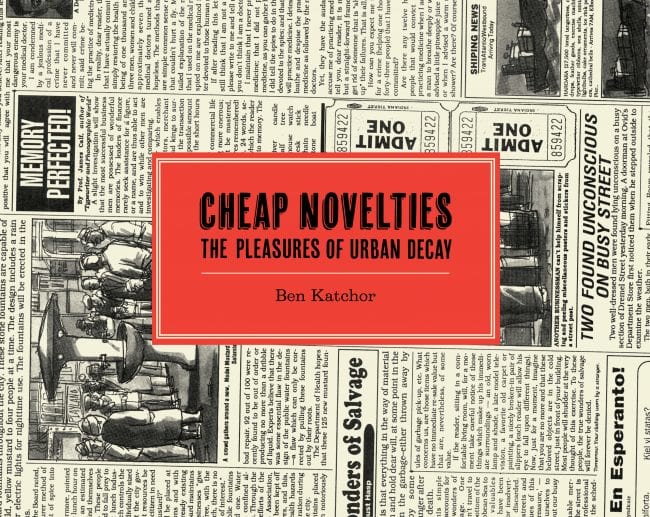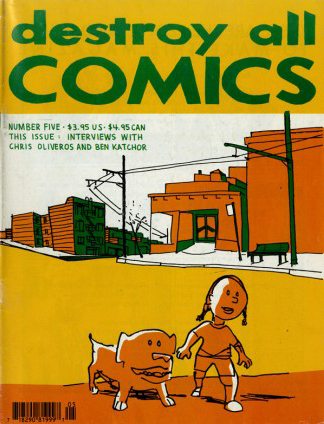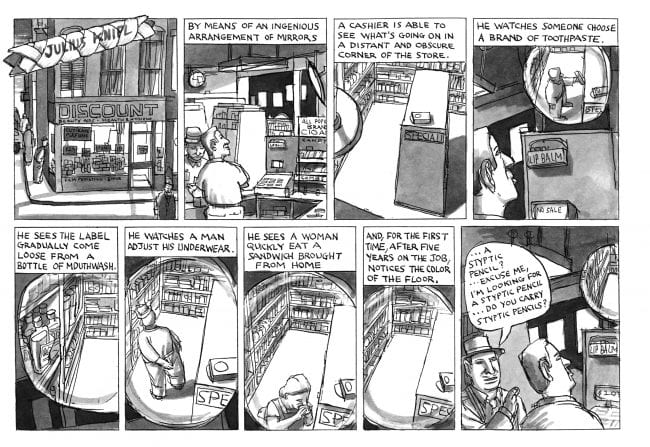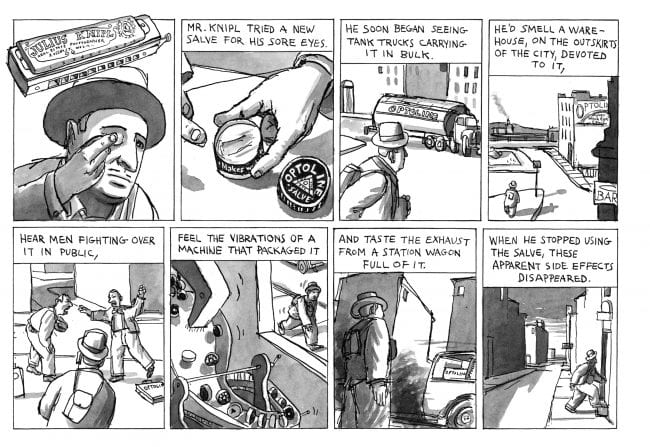 I was too young to learn about Ben Katchor from RAW. I learned about Katchor through Destroy All Comics, run by Jeff Levine with help from Dylan Williams, Frank Santoro, and others. This zine (published by Slave Labor Graphics (!)) was influential the way some blogs or twitters are influential now—flaring up as a node in a network for a year or two, then fading and dispersing.
I was too young to learn about Ben Katchor from RAW. I learned about Katchor through Destroy All Comics, run by Jeff Levine with help from Dylan Williams, Frank Santoro, and others. This zine (published by Slave Labor Graphics (!)) was influential the way some blogs or twitters are influential now—flaring up as a node in a network for a year or two, then fading and dispersing.
I think I first read Santoro’s Katchor interview while in study hall in high school. Do kids still sneak magazines into school to read during study hall?Like Chris Ware,the other big discovery for me i n high school due to Dylan Williams’ interview in Destroy All Comics Vol. 2, No. 1, there was a historical consciousness to Katchor’s work that felt new in comics. This kind of “reality based” historical or anthropological viewpoint felt like a new landscape for comics in the 1990s: an alternative to superhero continuity checklists, fandom’s specialist crate-digging, and to the sex and goofs of the underground. (The '90s also saw a sort of first blip of “cyber” and “electro” comics that started playing with computers as subject and metaphor and tool. It seemed “prog” at the time, but looking back there was some interesting stuff happening. Someone should put together a book of that kind of material? It was reacting to the graphics of computer games at the time, which were already threatening to change the face of comics forever...)
n high school due to Dylan Williams’ interview in Destroy All Comics Vol. 2, No. 1, there was a historical consciousness to Katchor’s work that felt new in comics. This kind of “reality based” historical or anthropological viewpoint felt like a new landscape for comics in the 1990s: an alternative to superhero continuity checklists, fandom’s specialist crate-digging, and to the sex and goofs of the underground. (The '90s also saw a sort of first blip of “cyber” and “electro” comics that started playing with computers as subject and metaphor and tool. It seemed “prog” at the time, but looking back there was some interesting stuff happening. Someone should put together a book of that kind of material? It was reacting to the graphics of computer games at the time, which were already threatening to change the face of comics forever...)
Destroy All Comics represented a weird new mix of punk DIY and cartooning classicism, and Ben Katchor fit this atmosphere of history. There was a kind of newsreel grain and grayness to all his work, an atmosphere not only of history, but a feeling that the comic strip itself could be coming from another time. If you have had one or two glimpses of an actual newspaper page, with comics, from pre-1925, you may have noticed its density and layout doesn’t quite feel like what we think of as newspaper comics. Old comic strips can seem impossibly large and strangely gray-looking. Katchor’s strips for the most part have a similar perverse grayness and rawness of the era of cheap mass printing presses.
*The exception to my characterization is the body of work comprised mostly of the strips Katchor drew for Metropolis magazine (beginning in 1998, and whose subscribers were primarily graphic design offices and architecture firms) and which are collected in Hand-Drying In America, (one of my favorite comic books of any kind published in the 21st Century), which are in muted, strange limited palettes of watercolor, I think? Lately he has been drawing everything digitally, which is another fascinating turn in his work (see here and other interviews for some discussion of this). These strips still appear every so often on the internet, as they have for years (Katchor as web cartoonist) and are available via the cartoonist's web site.
This short interview (here’s another, longer one at Paste Magazine from the same promotional swing) is on the occasion of Drawn & Quarterly reissuing his first book, Cheap Novelties; like all of Katchor’s books it is a masterpiece of bodegas, delis, and dialectics.
I’m finishing up a long project on restaurant history; editing an anthology; directing the Illustration program at Parsons School of Design; writing a new story for the Hotel & Farm collection, among other things.
I’ve heard you are running a good comics department over there at Parsons. How is that going?
We teach comics and animation within the Illustration program at Parsons. A student can minor in Comics and Graphic Narrative. We have many people on our faculty who work with text and image: Matthew Thurber, Bob Sikoryak, Lauren Redniss, Nora Krug, Steven Guarnaccia, Mark Newgarden, Josh Bayer, Henrik Drescher, Lale Westvind, Neill Swaab, James Romberger and some interesting animators: Ted Wiggins, Ana Mouyis, Motomichi Nakamura, Gary Leib and others. We’d like students to think of themselves as artist/authors working on self-initiated projects.
Parsons is unionized, right?
Only the part-time faculty are unionized at Parsons (SEIU); the full-time faculty are considered part of the administration and are not unionized. The part-time faculty union contract forbids them from striking.
Interesting. The school I’m teaching at, the Minneapolis College of Art and Design (MCAD) is currently going through some unionization voting and organizing.
The recent lock-out of all faculty at Long Island University and the ruling that graduate students can unionize are making it clear that without enormous endowments, it will become difficult for non-profit schools to cover their operating expenses — a good argument for funding “free” state, city and even national higher educational institutions, like in Europe.
I agree!
You give amazing lectures. Did teaching lead you to lecturing, or vice versa?
 I always enjoyed the public lecture form and so invented some of my own lectures on various subjects long before I was teaching. In my own classes I try to keep lectures under 15 minutes.
I always enjoyed the public lecture form and so invented some of my own lectures on various subjects long before I was teaching. In my own classes I try to keep lectures under 15 minutes.
I have to work on that. Studio art classes are definitely different than public lecturing. There's a weird mix of working and talking. It can be an adjustment to go from the desk to the classroom.
Anything you want to say about the reissue of Cheap Novelties? It looks great. Drawn & Quarterly did a nice job with it.
I’m happy that it’s back in print. The design and image quality are a great improvement over the original small Penguin paperback. It is an absolute pleasure working with Drawn & Quarterly.
I've been thinking a lot about cartooning this past year or so, and book design, and typography, and how the great cartoonists have been published over the years, what works and endures and what fades away. Do you get inspiration from collecting?
Most of my inspiration doesn’t come from the work of cartoonists, also I’m not very systematic in my approach to appreciation through collecting or studying of anything.
I’m always delighted to stumble upon a illustration by Robert Weaver that I haven’t seen.
As someone with a long view of the built environment, what do you think about the Interneti-zation of our lives in the past 15 years or so?
The access the internet affords us to archival material, independent journalism, social organizing, etc. should be a wonderful thing. Only because we’re physical beings this dematerializing of objects and minimizing of physical interactions has left people out of work and lonely. We’re ready for a guaranteed basic income scheme, so that people working in this immaterial realm can afford food, shelter and the theater.
What do you think about software design, our "cyber" environment, especially now that you’re working digital more often?
I was working with digital typesetting for years before this technology became adopted by the general public through “desktop publishing,” etc. and so the adjustment was just an opening up of access to more people.
You're drawings are also digitally produced now. How does that square with the dangers of dematerialization?
You could argue that hand-controlled input devices for drawing allow for more delicacy of touch and response — like the difference between a stethoscope and an electro-cardiogram.
Do you collect old newspapers and magazines, or do you visit libraries for your material, or is it mostly online research now? Do you have a large collection of old magazines and papers, or is New York full of enough archive material?

I haven’t collected anything for many years. Most of my research is done online, but I still like to wander the stacks of the NYU library or stumble upon the book of great importance sitting on the $1.00 rack outside the Strand bookstore.
Your work is primarily dealing with the pre-internet world, though you occasionally throw in an Internet reference. What do you think the challenges will be for cartoonists interested in depicting the graphical environment of post-smartphone life?
I did a short-lived strip for a very early internet magazine called, I think, Internet Life — it was a print magazine. The strip was called something like “A Walk on Nohital Street,” and was about the life of someone tied to their desk poking around the internet.
As long as we have physical bodies, the depiction of the physical world will interest me. The smartphone lives in the physical world, in the lint filled-pocket of an unemployed office worker who needs to find a restroom.








